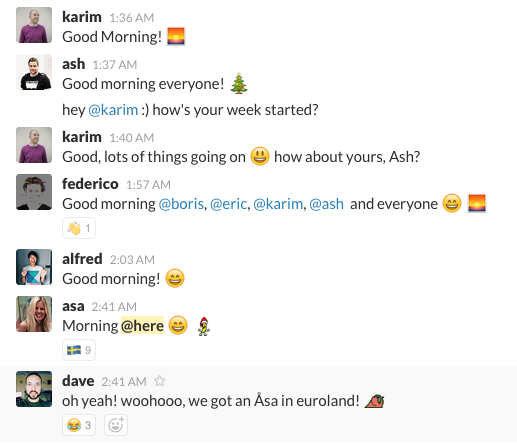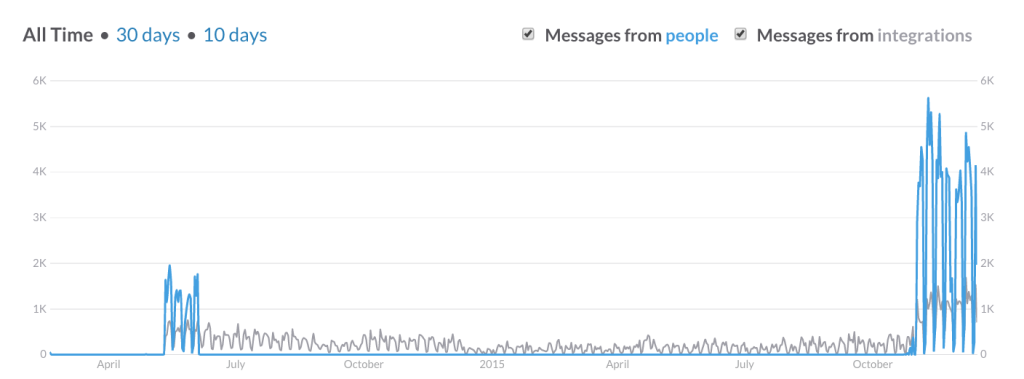Something a lot of people tend to be surprised about when they join the Buffer team (or even speak to a Buffer teammate for an extended time) is how specific, deliberate, and careful we are with the language we use.
There are literally no harsh words at Buffer, or at least none that I’ve ever heard. No brusquely worded requests, no passive aggressive notes, no office politics.
None of that. Only positivity and gratitude.
It’s a pretty great way to work.
As we work on living the Buffer values, we work on our language and communication as well, giving thought to every word and how it will be felt by its recipient.
We think the best of each of our teammates. We try to avoid certainty that our way is the best (or that there even is a best way). We answer in more words than needed (and often more smiley faces than expected) to make sure our message is clear and received positively.
What does this look like in practice? I’d love to show you!
This is a word cloud of the whole team’s communication on Slack, our main form of communication, over the last few months.
It’s a lot of fun to think on the patterns one can discover in here; I’ll share a few that I noticed especially.
Emojis
The words “simple smile,” “smile/grinning” and “thumbsup” are probably a bit better known as ?, ?, and ?.
Yes, emojis (and GIFs!) are a huge part of the way our global team communicates. They’re fun, positive and easy to understand in any language.
A smiley face is appended to at least half of all messages you might read in our Slack account :)
Some other favorites include:
- Party parrot
- Dancing banana
- And of course our Buffer icon



Uncertainty words: might, maybe, sense, probably, hunch
Seeing words like ‘”might,” “maybe,” and “sense” in the word cloud makes a lot of sense. At Buffer, it’s rare to hear to hear definitive words like “definitely” or “certainly.”
You’re far more likely to hear:
- It’s my intuition that…
- I sense that we could possibly…
- Might it work to…
- I sense that it could work to…
Less declarative words help us work on our value of listening, by taking the approach that everything is a hypothesis:

Great one!
Both “great” and “one” feature prominently on our word cloud, and I have a suspicion as to why.
“Great one!” is an exclamation you’re likely to read on Buffer’s chats pretty much every day. It’s how we greet many thoughts and questions from both teammates and customers.
In a spirit of positivity and gratitude, we’re grateful for all thoughts we get to hear from others, whether they take the form of praise, feedback, or a tough question. This is one of ways of sharing this gratitude and keeping lines of communication open and positive.
Greetings: heya, hi, morning
Slack is pretty much the way we each “log in” to the office every morning (or whenever we choose to work). Is it the same where you are?
And because of that, it’s the place where we tend to share our top-of-the-workday greetings. Here’s a recent morning:

Feel
Seeing the word “feel” along the lower right of the word cloud made me smile.
We talk a lot about how things feel at Buffer, as opposed to how they seem or what we think.
“How does that feel?”
“Feels like a great plan!”
“Feels great to me!”
We’ve learned that focusing on someone else’s feelings—as opposed to their thoughts or personal tastes—adds a deeper layer of empathy to the discussion. It shifts the focus from the item or task or object and places it onto the person.
Help, advice
Words like “help” and “advice” appear fairly prominently in our chats.
We’ve talked a bit before about how we use the advice process to make good decisions:
In general, the larger a decision, the more people you might ask for advice. For smaller decision, it’s ideal to speak with fewer people and for some, possibly with no one.

Getting help and advice come as second nature to most of us, and we’re all honored when we’re asked for advice or help from another teammate.
Tone
It was really neat to see the word “tone” in our word cloud. We talk a LOT about tone at Buffer–we find it’s very related to how something feels.
We’ve even got a “Buffer Tone Guide” that I find to be quite inspiring reading.
Some recent examples from Slack:
- “It’s really important to me to get the tone right here; would really appreciate your insights!”
- “I’m not quite sure I’ve got the voice & tone right at all here”
- “Love the positive tone and quick help!”
Gratitude: thank, love
It’s incredible seeing how popular words like “love” and “thanks” are on our word cloud.
Working at Buffer means being part of a culture of gratitude:

As a result, we express our thanks liberally (we even have a “gratitude” room in Slack that’s a wonderful place to hang out).
And a few more unique words you might hear at Buffer
These are a bit smaller in the word cloud but still important to the Buffer culture and language, so I thought I’d share them, too.
- Ceiling cat: One of the most handy memes for us is ceiling cat; perfect for use when you’re keen to speak up about a conversation not necessarily directed at you :)
- Reflect: Reflection is another one of our values, and you’ll often find a teammate sharing that they’d like to take some time to reflect on a decision or thought.
- Whole self: Bringing your “whole self” to work gets a lot of discussion on our team: How do we know when we’re doing it? How can we encourage more of it?
- Journey: There are many journeys at Buffer: It’s how we describe our invitation to join the team, and a teammate’s bootcamp process is a part of the journey as well. You might say we’re all on a journey together. :)
How our language has changed over time
We did this word cloud exercise once before, in 2014, when we were a much smaller team and experimenting with Slack for a few weeks. Here’s a look at the difference in communication volume over that time.

If you made a word cloud of your office conversations, what words would figure most prominently? I’d love to hear about them in the comments!
Try Buffer for free
190,000+ creators, small businesses, and marketers use Buffer to grow their audiences every month.



